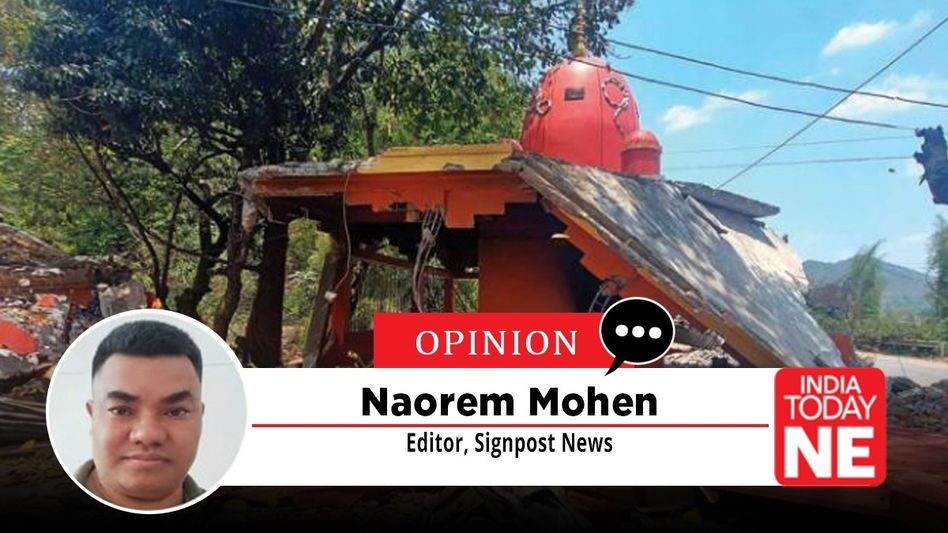Who will protect Manipur, the Last Hindu Bastion of the Eastern Frontier
The night of 3 May 2023 will be remembered as the day the gods of Manipur were driven into exile.In a single week of calculated violence, around 393 ancient temples were reduced to smoking rubble.

The night of 3 May 2023 will be remembered as the day the gods of Manipur were driven into exile.In a single week of calculated violence, around 393 ancient temples were reduced to smoking rubble.
Idols that had received milk and flowers for half a millennium were dragged through the streets, spat upon, smashed, burnt, and dumped into drains. The sacred idol of Ingourok Mahadeva – older than most European nations – was broken into pieces like ordinary stone. A 300-year-old living Shiva temple at Koubru Leikha was reduced to rubble in Kangpokpi, as though the very presence of Hindus has been outlawed.
On the holy peaks of Thangjing and Koubru, where Meitei kings once offered the first harvest to the guardian deities of the land, giant iron crosses now stand as silent declarations of conquest.Two and a half years later, over fifty thousand Meiteis – the Hindu people of the Manipur – remain refugees in their own motherland.
Their villages in Churachandpur, Kangpokpi, and Moreh have been ethnically cleansed. Their temples are occupied or bulldozed. This is not an “ethnic conflict.”
This is the final assault on the last surviving indigenous Hindu civilisation east of the Brahmaputra.
On 20 November 2025, the Sarsanghchalak of the Rashtriya Swayamsevak Sangh, Dr Mohan Bhagwat, visited Imphal. He spoke of peace, patience, social discipline, and the long, patient work of reconstruction. The words were noble, measured, and entirely in character.
But on the ground they landed like ash in the mouths of displaced mothers. Patience, to a Meitei widow from Moreh living in a relief camp in Akampat, does not feel like a virtue. It feels like watching her civilisation being strangled in slow motion while well-meaning elders lecture about non-violence and harmony.
When one community is heavily armed and the other has been deliberately disarmed by state policy, calls for “both sides to exercise restraint” ring hollow. When temples lie in ruins and crosses crown sacred mountains, appeals for “social discipline” sound like surrender dressed up as wisdom.
Coincidentally, the Meitei Hindus’ plight proves Mohan Bhagwat' warning: “Nobody listens to the weak.” Thousands displaced, temples razed, an ancient Hindu civilisation on the brink—yet Delhi remains silent.If the Sangh’s mission is to build a strong Hindu Samaj, Manipur is its most urgent battlefield today.These are our own people—bearers of Sanatan Dharma—under siege.The Meitei need the Sangh’s protection and organisational might. No Hindu homeland must fall. Act before it is too late.
In 1951, Hindus (including the Sanamahi-following Meiteis who proudly identify with Sanatan Dharma) constituted roughly 68 per cent of Manipur’s population. By 2011 that figure had crashed to 41 per cent. The religion tables of the 2021 census remain deliberately unreleased, but every village-level worker, every relief-camp volunteer, every honest official knows the truth: the decline has accelerated sharply in the last decade.
At the current trajectory – driven by conversions, displacement, and differential birth rates – the Hindu majority in Manipur could vanish within twenty-five to thirty years.This is not speculation. It is arithmetic.
Also Read: How the Nampi Conclave Became a Wake‑Up Call for Meitei Civil Society
Look honestly at the religious map of India’s eastern frontier since Independence and try to call it coincidence: Nagaland leapt from under 20 % Christian in 1951 to 87.9 % today; Mizoram went from roughly 35 % to 87.2 %; Meghalaya from less than 30 % to 74.6 %; Arunachal Pradesh, which had virtually no Christians at Independence, crossed 41 % by 2011 and is still the fastest-converting state in the country. Four states, seven decades, one relentless trajectory—ancient indigenous faiths almost erased, replaced by a single foreign creed that now controls politics, land, culture, and guns. The same playbook has worked without fail every single time, and Manipur is the last page still waiting to be written in the same blood and concrete. Even Assam, long considered the Hindu bulwark, witnessed the creation of the Bodoland Territorial Region along lines that enjoyed decisive church patronage.
Church organisations operating along India’s northeastern frontier have developed a consistent pattern when targeting tribal communities for missionary outreach and political mobilisation. They typically commission the creation of a distinct script—almost invariably based on the Roman alphabet—to foster a separate linguistic identity, and then promote demands for a new homeland by appending the suffix “land” to the tribal name, as seen in Nagaland, Bodoland, and the more recent calls for Kukiland. This strategy has been visibly employed by various church bodies active in the eastern border regions.
The World Council of Churches has expressed deep concern for the rights and future of indigenous tribal peoples. In the Darwin Declaration of May 1989, it adopted a clear policy supporting political separation and affirmed their right to full self-determination. This includes the pursuit of the complete range of autonomy, up to and including the establishment of their own independent nation-states, free from the jurisdiction of invading powers and the political structures imposed by them. The declaration asserts that indigenous peoples must have full control over their own institutions, including government, economy, and culture.
Furthermore, it places a firm obligation on both churches and governments to actively support the realisation of these rights by providing all necessary resources and assistance without any restrictions or conditions. Therefore, communities officially recognised in India’s Scheduled Tribes list are viewed by many churches operating in the country as particularly receptive or soft targets for missionary activities aligned with this broader agenda of separation and autonomy.
Every single one of those transformations was executed according to the same cold, five-phase strategy that has never once failed in the Northeast: first, amplify real grievances or simply invent new ones; second, arm one ethnic group under the noble label of “self-defence”; third, pour in unlimited foreign money disguised as charity (schools, hospitals, relief); fourth, demand “separate administration” that quietly morphs into full statehood or permanent autonomy; fifth, once the demographic majority is secured, erase the indigenous religion and culture so completely that even the memory of it feels like folklore. That script wrote Nagaland, Mizoram, and Meghalaya into history as Christian homelands. Today it is being performed again, word for word, in the hill districts of Manipur.
Manipur is now deep into Phase 4. The repeated demands for “Separate Administration” for the Kuki-Zo areas are not a search for peace. They are the Nagaland-Mizoram script being rerun with new actors.
The ground reality is this: every month of delay is another cohort of Meitei children growing up in relief camps, another dozen villages quietly tipping into the conversion column, another ancient shrine abandoned forever.
Like the Pandits of Kashmir in 1990, the Meiteis of Manipur in 2023 discovered overnight that their own state had become enemy territory. Their crime was their faith and their ethnicity. Their punishment was exile within their own nation. National media painted them as the aggressors while they buried their dead. International outlets discovered “tribal rights” only when one side was Christian.
In camp after camp I have heard the same whispered question from exhausted mothers and grandmothers:
“If being Hindu means my children will remain refugees forever, if it means our gods have no protectors, while the church offers food, education, and a new homeland with armed security – tell me honestly, what should I do?”
That question should scorch the conscience of every Hindu home in mainland India. When hope dies, conversion is no longer coercion. It is the only door left open.
Sanamahism is not a “separate tribal religion.” It is the deepest, most ancient layer of Sanatan Dharma still breathing on Indian soil. Its worship of Lainingthou Sanamahi, Leimarel Sidabi, and the Umang Lais is the same primordial reverence for nature, ancestors, and cosmic order that underlies the Rig Veda itself.
When a sacred grove is bulldozed for a concrete church in a remote foothills village of Meitei, when a child is taught in mission school that his ancestors worshipped demons, it is not just Meitei culture that is murdered. A fragment of the soul of Sanatan Dharma dies with it.
If even the Meiteis – heirs to a 2,000-year recorded civilisation, defenders against Burmese invasions, proud bearers of both Vaishnava and Sanamahi traditions – fall to the same pattern that consumed Nagas, Mizos, and Khasis, then no tribe left in the Northeast will ever again believe that Hinduism can protect them.
Akhand Bharat will shrink before our eyes, and the saffron flag will retreat forever west of the Brahmaputra. Political will in Delhi to treat Manipur as a civilisational red line, not a routine law-and-order file. The Meitei Hindu will become a historical curiosity, like the Buddhists of Afghanistan or the Zoroastrians of Persia.
This is not the time for another committee, another peace delegation, another photo-op with folded hands.Manipur requires emergency measures of the kind that were never hesitated over when the nation’s security was deemed at stake elsewhere:Immediate, militarily protected resettlement of every displaced Meitei family to their original villages – no excuses, no delays.
Future generations will not remember how many shakhas we ran in Madhya Pradesh or how large the Vijayadashami gatherings were in Nagpur. They will ask one question, and one question alone:When the last Hindu kingdom of the eastern Himalayas was burning,
when its ancient temples lay in ashes,
when its women and children huddled as refugees in their own motherland,
when its sacred mountains were crowned with symbols of conquest,
what did Hindu society do?
Did we act with the urgency that the survival of Sanatan Dharma demanded?
Or did we console ourselves with words of patience while an entire civilisation bled out in silence?
Manipur is the final frontier. There is no fallback position, no second line of defence, no next Hindu kingdom waiting beyond the Brahmaputra. If Manipur falls, living Hindu civilisation vanishes forever from India’s eastern horizon. The sacred peaks of Koubru and Thangjing, guardians of the Meitei soul for millennia, will be reduced to forgotten names on old maps (mountains whose very names future generations will struggle to pronounce, whose gods will survive only as footnotes in dusty anthropological studies).
This is the raw, unfiltered cry of a Meitei Hindu who refuses to vanish in silence, who refuses to let two thousand years of living Sanatan civilisation be erased without a fight. We have no more land to retreat to, no more valleys to fall back on, no more generations to sacrifice on the altar of patience.
If Manipur is abandoned now, Bharat’s east is lost forever, and the saffron will retreat west of the Brahmaputra for all time. Save Manipur today, or tomorrow there will be no Hindu left in the entire Northeast to save. The question is no longer theoretical; it is burning in the eyes of every displaced child and widowed mother huddled in relief camps: when the last Hindu kingdom of the eastern Himalayas is bleeding out, who will protect the Meitei Hindu?
Copyright©2025 Living Media India Limited. For reprint rights: Syndications Today









